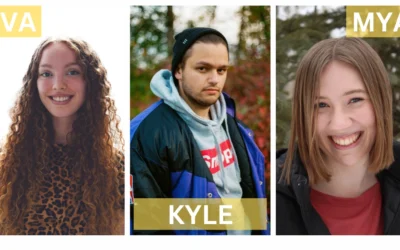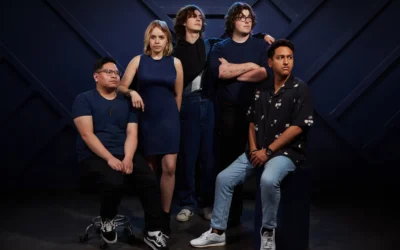Local fashion designer Nikki Ewing opened Dark Knits Boutique in 2006 and is located in Callingwood, near West Edmonton Mall. The studio specializes in custom corsetry, or the art of corset making, and has since branched into bridal, costumes, and cosplays as well. The boutique treads the line of Avante garde, usually with darker elements either gothic or punk.
“I’m at a point where if you can name it, it’s probably doable by now,” Ewing says.
Ewing’s most recent collection was inspired by fantasy and wings. “I try to do one collection a year to try to get my itch out on all the weird stuff that I want to make, so I’ve done a lot of creature-inspired collections.”
Each full-body outfit includes a pair of wings and a corresponding corset. The wings are made of different materials: fabric, feathers, and even some with wires which allow the wings to extend.

The most recent collection was shown in July 2019 at Edmonton’s Fashion Fest, where along with female models of different sizes, Ewing also had male models, “something I have never been able to show on the runway,” she says.
Ewing states that while women tend to be more comfortable in tight clothing, men are not. “The men’s bodies are different, their ribs are a little lower, closer to their pelvis, so there is less squish room,” she explains.

“I go out of my way to bring diverse and inclusive collections to the runways and photo sets I showcase on. I feel it matters more than I can say, and I have had a great deal of positive feedback from audiences all over that the diversity and inclusion that we showcase is a wonderful breath of fresh air in an industry that is often confined to very few shapes and sizes,” says Ewing.
Starting out, however, wasn’t easy.
Ewing describes the beginning as a “learning wall.” It was rough. There was a big learning curve not only with sewing her creations but with the launch of a small business.
“As a one-woman show at first, it was a lot to juggle, a lot to manage. But my sewing skills have grown a lot. The company has grown,” she explains.
Ewing, who started her professional life by earning a degree in civil engineering, picked up her love of corsetry and fashion from her grandmother. “My grandma taught me how to sew corsets. It’s always had a warm spot in my heart,” says Ewing.
She felt encouraged to pursue the art of corsetry because it was an art form that she didn’t want to see get lost with future generations. Ewing’s grandmother taught her the basics of corset making, and Ewing mastered the craft when she was diagnosed with Ehlers-Danlos Syndrome (EDS) roughly 12 years ago. Initially, her work with corsetry was based on trial and error as she explored the different ways she could create a corset that would support her joints.
The condition affects tissues in the body, “which means my joints are lax and they pop out,” she says. EDS can cause the skin to be thinner and more easily bruised. Although there is not a cure for it, EDS can be treated with braces.
“My grandma taught me how to sew corsets. It’s always had a warm spot in my heart.”
Nikki Ewing
Ewing found the support braces that she received from Albert Health System (AHS) to be rigid and inflexible. “They were really painful to wear,” she says. “They cut in and they were kind of known for causing leg pain and some- times nerve damage. And I wasn’t OK with it. I wasn’t OK with adding more pain to my already sore joints.”
Ewing credits corsetry for fixing her “sloppy joints.”
Where Ewing once needed a cane to help her around, her family members witnessed the improvement in her first hand. Through corsetry, Ewing noticed a change in her back and her hips especially.

“They became more stable. I was genuinely a happy human being because I wasn’t in pain, which made it easier for me to explain to people first hand that corsetry isn’t that ancient torture technique,” she says with a laugh.
Anything that helps with the pain or prevents a dislocation or subluxation is golden, she says. Subluxation refers to when dislocated joints return back to their original position without medical aid. Ewing has made supportive corsets for others diagnosed with EDS, stating that the pain is so bad, even if the corsets help once, it’s worthwhile.

Health benefits of corsets include better posture and pain relief. When used correctly and safely, corsets can also be used to train waists. Although there are modern styles of waist trainers, as advertised by the Kardashians, steel-boned corsets offer better, longer-lasting results. Improper use of corsets can harm organs and bone structures.
Whale bones can no longer be used in corsetry because whales are listed as an endangered species. Ewing uses a combination of steel bones with different levels of elasticity, depending on the piece she is creating.

Ewing understands the need for larger sizes. “I have family members who have unfortunately large chests, which is hard on the shoulders and hard on the back,” she says.
“With the way modern lingerie and specifically bras are built, they don’t really support chest sizes that large. Corsetry helped me to help them with their back pain.”
Ewing believes that some people may struggle with the idea of corsetry because it is not prêt-à-porter item. “A lot of people shy away from it because they think it’s troublesome or they just don’t know where to begin. There aren’t any off-the-rack solutions for corsetry,” she says. Ewing explains that corsets have to be made to order.
No two bodies are the same, because no one squishes the same. “Nobody’s ribs or pelvis are in the same position as someone else,” says Ewing.
Ewing admits that, now that her business has grown, she is a little picky when choosing which clients to take on. This is only because of the intimacy that comes with creating corsets.

“It doesn’t matter what I’m creating if the clients don’t appreciate the process and the work that goes into it,” she says, adding that she refuses to take the joy out of work she genuinely enjoys.
That said, Ewing’s skills extend past corsetry. In August 2018, Ewing and her apprentices successfully recreated a character from DOTA, a multiplayer online battle video game.
“It was a centaur piece complete with walking legs. You name it, it was there,” Ewing says, the pride in her voice evident. “It’s probably the craziest thing I have ever made to date.”
The piece was made with shark fishing wire and foam to allow the back legs to move in time with the model. “It was one heck of a piece,” she says.
The piece, which took eight months to make took home a Top 10 prize at the International DOTA2 championship’s costume contest. “We had to take some frustration time away from it, there was a lot of cursing.”

Ewing says she was inspired to make it with her apprentice who convinced her to work on the piece. “Had anyone else asked me to make it I would have said ‘hell no,’ but because it was my apprentice and she worked with me through it, I agreed. We worked through the challenges together.”
But the walking centaur may come second to Ewing’s own wedding gown. The two-piece gown features a sweetheart corset with a drop waist. The skirt is composed of in-housemade lace and is decorated with Swarovski crystals in the middle of 3-D roses, which cascade asymmetrically around the dress.
When it came to her own gown, for Ewing anything was possible.
“I had such a hard time just nailing down the design that I could stick with for more than 30 seconds because the sky was the limit to do anything I wanted, and trying to figure that out was a lot harder than I had anticipated.”
Ewing jokes that her apprentices tease her, saying, “they say that one should make other peoples’ gowns but not their own.”

Although the gown took Ewing approximately 80 to 100 hours to assemble, the intricate lace took one year to make on its own.
“The first lace that started this whole custom (of the studio making lace) was a gothic bride who wanted a skull lace overlay,” Ewing says.
“I couldn’t find lace in the market anywhere that wasn’t cheap Halloween lace. I wasn’t going to put that on somebody’s wedding gown, and I knew I could make free-standing lace.” So, the boutique got lace sheeting.
The studio has continued making in-house lace ever since.
Every one of Ewing’s pieces reflects her creativity and her love for fashion. “Fashion is a means of expression and a gift I can pass along to others. I can help others feel amazing, and that to me is the best thing I can ever do.”





0 Comments